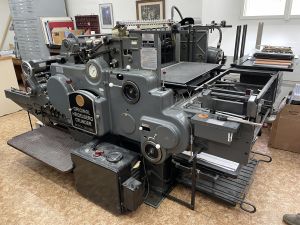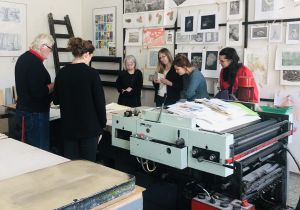Events
Photomechanical talks at the Institute of Art History, Prague
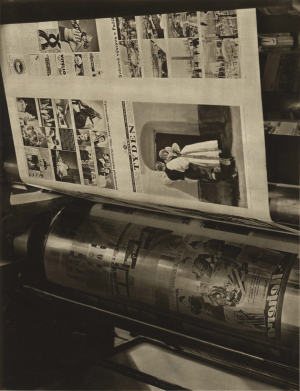
i
Cover of Pestrý týden, 11 December 1937
February–May 2024
#lecture series
The PhotoMatrix project (Institute of Art History of the CAS, Prague), organizes four talks of the Collegium Historiae Artium lecture series:
14 February 2024
Meghan Forbes (independent scholar, New York, PhotoMatrix project collaborator)
"Devětsil and the Aura of Mechanical Reproducibility"
This talk by Dr. Meghan Forbes will present a popular topic from a new angle, turning once again to the books and magazines made by the interwar Czechoslovak avant-garde, but with a view towards how they were produced. Drawing on Forbes’s forthcoming book manuscript, Technologies for the Revolution: The Czech Avant-Garde in Print, the talk will introduce advancing forms of print technology — including letterpress, lithography, and photomechanical image-making — that Devětsil utilized to create an impressive trove of printed matter. By offering insights into the modes of mechanical reproduction available in the 1920s, the necessary collaborations with print professionals, and the economy of distribution, Dr. Forbes aims with her work to bring new, material meaning to the theoretical and artistic concepts for which Devětsil is already so well known, such as the picture poem and Poetism.
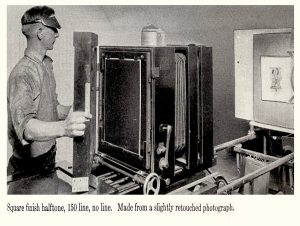
28 February 2024
Camilla Balbi (IAH CAS, PhotoMatrix project researcher)
"A Forgotten Media Interest: Erwin Panofsky and Photography"
This talk by Dr. Camilla Balbi delves into the persona of Erwin Panofsky, one of the most important art historians of the last century, from a new, mediological perspective. Drawing from Balbi’s forthcoming book, “Erwin Panofsky and Modernity: Painting, Photography and Film”, the discussion will focus on Panofsky's exploration of the photographic medium.
A remarkable aspect of this analysis lies in Panofsky's efforts to understand the medium beyond its artistic realm. The pages devoted to the interplay between painting and photography extend to medial considerations of their social applications, be they scientific or museological. This exploration navigated the urgent theoretical debates of the time, engaging in dialogue with renowned personalities such as Max Sauerlandt, Siegfried Kracauer, and Heinrich Schwarz.
The lecture unfolds the historical and theoretical layers in Panofsky's writings on photography. It deals with the interplay between originality and reproduction and the nexus between knowledge and visualization. Finally, the lecture explores the impact of Panofsky's exploration of photographic technique on the birth of iconology, revealing a surprising connection between his reflections and the ethos of contemporary Bildwissenschaft.
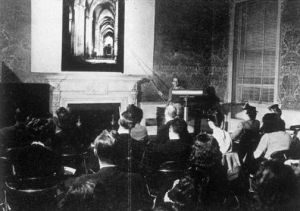
i
Ewrin Panofsky teaching at New York University, ca 1933
24 April 2024
Anthony Hamber (independent photographic historian, London)
"The 1840s: Transformations in Reprographics"
In January 1839, when the photographic processes of Daguerre and Talbot were announced, there was an existing, mature, and extensive printing and reprographics industry in all industrialised countries. The most significant printing process was that of lithography. Almost immediately there was a wave of experimentation in developing a photomechanical process. Those experimenters were primarily scientists and did not form part of the existing reprographics industries. Photographic historians have tended to repeat the same list of experimenters, primarily from France, Austria, and the United Kingdom. Emerging evidence suggests that during the 1840s—described as a comparative “gap” in scholarly research—photomechanical experimentation was in fact more widespread. This paper examines the speed of the distribution of news of Daguerre’s and Talbot’s processes and discusses a number of the photomechanical experiments that followed. A key consideration examined is why the contemporary printing and reprographics industries did not adopt photography during the 1840s to develop commercial photomechanical processes and accompanying services. A short case study underlines how one individual, with much experience in transfer lithography, played a crucial role in the late 1850s in the development of photozincography at the UK’s national cartographic agency (Ordnance Survey).
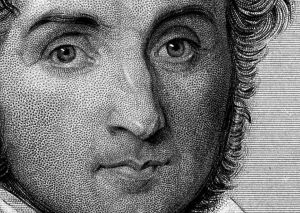
i
Detail of portrait of Justus von Liebig. Stipple engraving by J. B. Hunt, after W. Trautschold, 1840. 1845
15 May 2024
Kim Timby (École du Louvre, Paris)
"Bringing Home the Museum: The Colour Turn in Art Reproduction in the Mid-Twentieth Century"
Color art reproduction made newspaper headlines in France circa 1950. These vivid photographs of artworks suddenly appeared to be everywhere, most notably in books and as large-format images for wall display. It had long been possible to photograph in color. However, I will argue that this kind of photography became "new" around the time of World War II because that was when it started to circulate in mass-market, printed form. The commercial success of color art reproduction was underpinned by a real demand for more naturalistic renditions—of paintings, in particular—but also by promotion by esteemed intellectual leaders who saw it as a way to democratize great masterpieces. This innovative imagery thus had important cultural repercussions, sparking a public conversation of unprecedented proportions about the value of art in modern society.
Venue: Institute of Art History of the CAS, Prague, Husova 4, general meeting room (117), 1st floor
Time: 4:30 PM CET
For the Zoom link, please contact us at: masterova@udu.cas.cz
Meghan Forbes:
Devětsil and the Aura of Mechanical Reproducibility
2024-02-14
#invited lecture
This talk by Dr. Meghan Forbes presented a popular topic from a new angle, turning once again to the books and magazines made by the interwar Czechoslovak avant-garde, but with a view towards how they were produced. Drawing on Forbes’s forthcoming book manuscript, Technologies for the Revolution: The Czech Avant-Garde in Print (2025, Artefactum and Karolinum University Press), the talk introduced advancing forms of print technology — including letterpress, lithography, and photomechanical image-making — that Devětsil utilized to create an impressive trove of printed matter. By offering insights into the modes of mechanical reproduction available in the 1920s, the necessary collaborations with print professionals, and the economy of distribution, Dr. Forbes aims with her work to bring new, material meaning to the theoretical and artistic concepts for which Devětsil is already so well known, such as the picture poem and Poetism.
The invited lecture took place on 14 February 2024 as part of the Photomechanical talks within the Collegium Historiae Artium lecture series at the Institute of Art History of the Czech Academy of Sciences. It was introduced by Dr. Hana Buddeus (IAH CAS). The video is a Zoom recording.
pdf poster
Camilla Balbi:
A Forgotten Media Interest: Erwin Panofsky and Photography
2024-02-28
#invited lecture
This talk by Dr. Camilla Balbi delved into the persona of Erwin Panofsky, one of the most important art historians of the last century, from a new, mediological perspective. Drawing from Balbi’s forthcoming book, “Erwin Panofsky and Modernity: Painting, Photography and Film” (2024, Mimesis, Milano), the discussion will focus on Panofsky's exploration of the photographic medium. A remarkable aspect of this analysis lies in Panofsky's efforts to understand the medium beyond its artistic realm. The pages devoted to the interplay between painting and photography extend to medial considerations of their social applications, be they scientific or museological. This exploration navigated the urgent theoretical debates of the time, engaging in dialogue with renowned personalities such as Max Sauerlandt, Siegfried Kracauer, and Heinrich Schwarz. The lecture unfolds the historical and theoretical layers in Panofsky's writings on photography. It deals with the interplay between originality and reproduction and the nexus between knowledge and visualization. Finally, the lecture explores the impact of Panofsky's exploration of photographic technique on the birth of iconology, revealing a surprising connection between his reflections and the ethos of contemporary Bildwissenschaft.
The invited lecture took place on 28 February 2024 as part of the Photomechanical talks within the Collegium Historiae Artium lecture series at the Institute of Art History of the Czech Academy of Sciences. It was introduced by Dr. Katarína Mašterová (IAH CAS). The video is a Zoom recording.
pdf poster
Publications
The (Theoretical) Elephant in the Room. Overlooked Assumptions in Computer Vision Analysis of Art Images(by Camilla Balbi and Anna Calise)
2023-11-06
#academic journal paper
Contemporary computer vision software represents an incredible opportunity for both art history researchers and museum practitioners: it is a tool through which images can be described, organized, studied and shared. In this process—the one in which a computer vision software operates over a database of art history images—there are however a variety of dynamics at play. They have to do with theoretical assumptions, historical categories, technological constraints and ideological stances: a set of premises which calls for a closer methodological survey of the process. We propose an account which uses art theory and visual culture studies to scrutinize the different steps and activities which constitute the computer vision analysis: after all, the study of images has historically been a prerogative of art historians. Our intuition is that art images databases somehow provide a “protected environment” in which to observe how old problems, inherent to the discipline, interact with new problems created by the way we consume and design software. The three levels at which we will try to detect biased stances answer three different questions. Which images are we talking about? Which research questions are we asking? Which linguistic and political logics are at play? In order to do so, we will begin the discussion by debunking the myth of a simple parallelism between these new forms of conceptualizing the real and traditional ones, challenging Manovich’s (1999) use of Panofsky’s symbolic form (1927) as a hermeneutic of the database. We will show instead how the art-database logic somehow sticks to the traditional art historical narrative, while at the same time producing new kinds of biases. Then, we will focus on how this technology actually works, and which kind of art historical thought lays behind the algorithm. Our guess is that the praxis of this software is closer to the connoisseurship than to the art historical research. Thirdly, we will analyze the labeling process through which computer vision software creates descriptive metadata of the images in question, using Mitchell’s critical iconology (1994) account to problematize the strong ideological and political stance behind the image-text relationship. Throughout the discourse, and especially in the final paragraph, we will address the transparency and evaluation standards which need to be defined in order to allow a strict methodological approach to guard and guide the process, at times lacking both in the cultural sector and in the wider visual field. What will emerge is an account of computer vision software and processes which appear to be far from ‘neutral’ or ‘objective’ in their extremely layered functioning, built in the midst of diverse stakeholders’ interests and procedural false steps. Granted that these technologies are however contributing to build the visual culture of our time, we detect a series of overlooked assumptions along the way through the lenses of art theory, hoping to contribute to the design of a clearer view.
Keywords: artificial intelligence, digital archives, image, art, ideology
Camilla Balbi and Anna Calise, The (theoretical) Elephant in the Room. Overlooked Assumptions in Computer Vision Analysis of Art Images, Signata [En ligne], 14 | 2023.
URL : http://journals.openedition.org/signata/4757
DOI : https://doi.org/10.4000/signata.4757
La Tour Eiffel, ou l’histoire d’un cliché: une image-fétiche de l’avant-garde entre France et Tchécoslovaquie(by Fedora Parkmann)
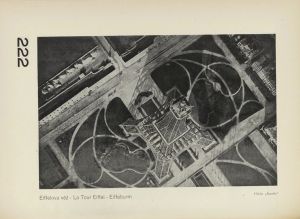
i
Anonymous [Karel Teige], “Eiffelka, čili historie jednoho klišé” [The Eiffel tower, history of a printing-block], ReD, vol. 2, No. 7, March 1929, p. 222. © National Gallery Prague 2022.
2023-05-01
#book chapter
The Eiffel Tower, History of a Printing-Block: An Avant-garde’s Favourite Between France and Czechoslovakia
This book chapter traces the successive appearances of an aerial view of the Eiffel Tower in French and Czech publications between 1909 and 1928. The image proved particularly inspiring to the avant-garde as it switched contexts from Karel Teige and Le Corbusier’s publications to the paintings of Robert Delaunay. By pointing out the changes in formal adjustment and meaning that the image underwent, this case study provides a measure of the circulation of photo-reproductions within avant-garde networks and their repercussions in artistic work.
Keywords: Eiffel Tower, photography, Karel Teige, Le Corbusier, Robert Delaunay, photographic reproduction
Fedora Parkmann, "La Tour Eiffel, ou l’histoire d’un cliché : une image-fétiche de l’avant-garde entre France et Tchécoslovaquie", in Léa Saint-Raymond (ed.), La circulation des images en Europe, Paris: Mare & Martin, 2023, pp. 189–202, ISBN 978-2-36222-085-2.
Dis/placed Modernism: Ellen Auerbach and Marianne Breslauer’s Palestine(by Camilla Balbi)
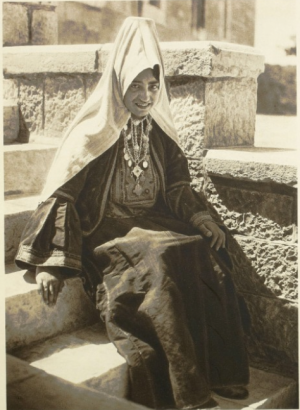
i
K. Gröber, Married woman from Bethlehem, 1925. Gravure printing photograph. In ID., Palästina, Arabien und Syrien: Baukunst, Landschaft und Volksleben, p. 112. Copyright expired.
2023-08-26
#academic journal paper
This paper addresses geographical displacement, elsewhereness, as a fundamental experience in early twentieth-century culture. It examines its aesthetic and epistemological consequences in the specific context of German-Jewish women's photography created in pre-state Israel during the 1930s. The article focuses on photographs taken during the Palestine sojourns of two prominent photographers from the Weimar Republic: Marianne Breslauer and Ellen Auerbach. The two moved not only through geographical locations, but also through intersecting imaginaries, ethno-religious and gender identities on the margins of discourses and political systems: as women, as Jews, and as photographers. The article explores these balances at a delicate historical juncture: when a distant spiritual homeland slowly becomes a complex territory for very complicated immigration, and travel photography turns into exile photography. The resulting photographs exist within a dynamic interplay between ancient collective memories of the “Land of the Bible” and the modernist iconographies associated with Zionist nation-building, the enchanted gaze towards the Arab East, and a German training altered by displacement. Finally, from a theoretical perspective, the study examines how the displacement of the two photographers partially decentered their modernist background, expanding the dimensions of the modernist canon to include nomadism, memory, and longing.
Keywords: Ellen Auerbach, Marianne Breslauer, Weimar Photography, exile, Palestine
Camilla Balbi, “Shifting Paradigms — Mexico in color: Ellen Auerbach’s exile photography”, Itinera, no. 23: Colour: Photography, Image, Reality / Aesthetics, Technique and Emotion, 2022, pp. 115–130, ISSN 2039-9251.
CIHA Panel
Photomechanical Prints andthe Material Agency of Images
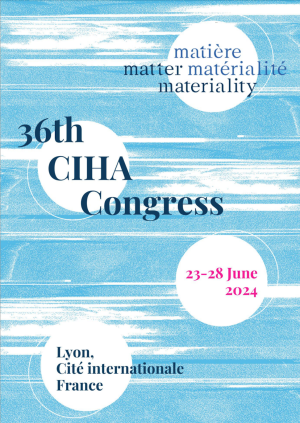
The panel within the 36th CIHA (Comité International d'Histoire de l'Art) World Congress proposed by Fedora Parkmann, Katarína Mašterová and Hana Buddeus. The theme of the congress is “Matter Materiality”.
23 – 28 June 2024, Lyon, France
Photomechanical prints are rarely considered as objects in their own right. They tend to be relegated to the role of invisible intermediaries that provide access to various types of photographic images, whether artistic or informational. Previous research on the history of photomechanical printing technologies has revealed how crucial these inventions were in establishing photography as the primary means of visual communication in the 20th century. Moreover, the recent material turn in photography studies has shifted the focus from aesthetics and subject matter of photographs to their materiality, from art historical interpretation to the study of the uses, circulation, and social contexts of photographic objects. This panel aims to expand our knowledge of photomechanical prints and to challenge their perceived transparency by exploring their material appearances and social agency. To what extent did the materiality of photomechanical prints influence their social uses? How did the dissemination of photomechanical prints in various formats – books, journals, postcards, or decorative objects – serve art, culture, commerce, or science? These questions are all the more topical today because many such documents are now available in digital form, radically changing the way we perceive and study them. The social impact of photomechanical prints will be studied from the first inventions to the boom of the halftone and other processes used in the 20th century.
We especially welcome interdisciplinary and cross-cultural contributions that investigate photomechanical prints in relation to regions and topics previously regarded as marginal in art history. Potential papers will be organized around the following aspects of photomechanical printing:
1) materials and formats,
2) transregional communication,
3) their role in shaping knowledge,
4) the construction of identities.
Call for Papers
The call for papers has been closed by 1 October 2023.
https://www.cihalyon2024.fr/en/call-for-papers/thinking-about-matter-2-penser-la-matiere-2/photomechanical-prints-and-the-material-agency-of-images
Applications via: https://www.cihalyon2024.fr/en/call-for-papers (select Thinking about Matter 2)
https://livebyglevents.key4register.com/key4register/Abstract.aspx?e=148&abslogout=1&culture=en-GB
Program
To be announced in December 2023.
Venue
Centre de Congrès de Lyon
50 Quai Charles de Gaulle
69006 Lyon, France
Workshops
Printing Shop excursion a the Hellichova Prague Graphics School
2023-05-20
#technology workshop
The Matrix project team took part in a specialized workshop on print production in the last century. The showcase of techniques and machines used was prepared by a former teacher, printmaker, and specialist in printing technology Mr. Jaroslav Čermák. The workshop took place at the College of Graphics and Secondary Technical School of Graphics (the Prague Graphic School) and the Institute of Art History of the Czech Academy of Sciences.
Presentations
Rachel Wischnitzer and the Photomechanical Foundations of Jewish Art History(by Camilla Balbi)
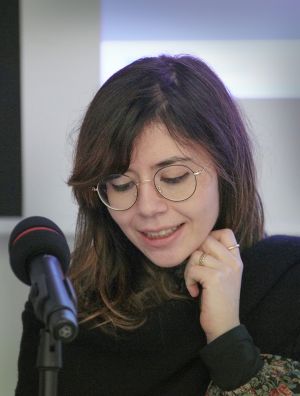
2023-12-05
#conference talk
From 1921 to 1924, Berlin became one of the epicenters of the so-called “Weimar Jewish Renaissance” (Brenner, 1996): a golden age of cultural, artistic, and literary activities that for the first time sought to address a specifically Jewish audience and create a Jewish public sphere. Flooded with refugee Jewish intellectuals from Eastern Europe, the city became an ideal platform for the rise of Jewish books, whose publication and dissemination was facilitated by low-cost printing and postage during the years of hyperinflation. Printed in Germany, these books were exported around the world.
For intellectuals interested in art history, this was the first opportunity to present a significant amount of Jewish visual material to the public. The material, often locked away in archives or located in remote regions of the Middle East or Eastern Europe, had previously received little attention as an object of study. The most significant attempt to include it in the Western art-historical and theoretical debate was made by Rachel Wischnitzer, a Russian-born art historian, in her bilingual (Hebrew and Yiddish) magazines Rimon/Milgroym, published in Berlin between 1922 and 1924. These magazines are considered ”the most beautiful and interesting journals of Jewish art that ever appeared” (Fuks, 1988).
In the proposed paper, I will reconstruct the material history of the magazines using archival material from the Leo Baeck Institute. This involves investigating the production, reception, and afterlife of the photomechanical reproductions they contain. The reproductions resulted from a complex interaction of academic scholarship and avant-garde research (noteworthy is El Lissitzky’s engagement in producing some of the pictures of the Mogilev Synagogue) which played a role in preserving what was, in some cases, the only visual evidence of artworks that perished in the war, thus bringing to light the construction of the first Jewish transnational visual culture.
Art within Reach: Photomechal Reproductions of Work of Art from Print to Digital, 5–6 December 2023, Institute of Art History, Czech Academy of Sciences, Prague
The Production of Photomechanical Reproductions of Art: Consensual Exchange, Stolen Glances and Embellished Reality(by Hana Buddeus)
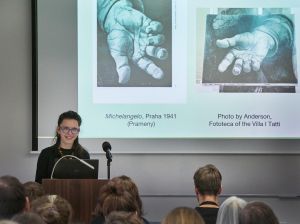
2023-12-05
#conference talk
While the subject of photographic reproductions of artworks has recently garnered increasing attention, a comprehensive understanding of their complex production and distribution remains far from complete. In the wake of the material turn, many photography historians have shifted their focus from aesthetics to the very physical aspects of the medium. This newfound fascination with the material essence is evident in the heightened scrutiny of the tactile attributes of its diverse manifestations, including printed photomechanical reproductions.
Based on research within Czech archives, this paper undertakes an examination of the diverse material embodiments of photography interwoven with the complex process of producing reproductions for art magazines. It delves into the methods embraced by editors of art and art history journals published in the first half of the 20th century (Volné směry, Život, Umění) that span from commissioning original shoots and buying pictures by renowned photographers and photo agencies to exchanging photographs on both national and international level, and even rephotographing existing reproductions sourced from foreign magazines. The archival findings vividly showcase how the term “photography” is rich in meaning, materializing in a variety of forms (prints, glass and film plates, and process blocks) dictated by the chosen printing process and the desired outcome.
Moreover, it reveals how the post-production phase, involving nuances such as background adjustments, cropping, size modulation, and contrast refinement, played an integral role in the journey that culminated in the creation of seemingly "transparent" images. Shedding light on these conventional yet invisible tools promises to unravel the intricate dynamics of decision-making, communication modalities, and exchange strategies that underlie the process of producing the photomechanical reproductions of artworks.
Art within Reach: Photomechal Reproductions of Work of Art from Print to Digital, 5–6 December 2023, Institute of Art History, Czech Academy of Sciences, Prague
Behind the Photographs: Copyright and Photomechanical Reproductions of Art, a Burning Issue in Europe at the Turn of the 20th Century(by Marta Binazzi)

2023-12-05
#conference talk
In the 1890s, owners of photographic companies based in Europe formed unions or associations specifically devoted to the protection of photographic copyright. Their main objective was to ensure that photographers were protected against unauthorized reproduction of their work by publishers and the illustrated press. The industrialization of photomechanical processes, and in particular the introduction of halftone printing, greatly expanded the possibilities of photographic reproduction. Images could now be disseminated through books, journals, but also postcards, various objects and advertisements, which circulated widely, becoming transnational products. In this new international scenario, with non-existent or unclear laws protecting photographs, publishers could reproduce them using photomechanical processes without paying any reproduction rights. Moreover, reproductions of artworks raised problems of ownership and copyright that other photographs did not, fostering intense debates.
This paper analyzes the institution of these unions while also focusing on selected lawsuits between the 1890s and the 1920s that dealt with the unlawful reproduction of photographs of artworks. By examining these sources, the paper exposes the overlooked processes of production of photomechanical illustrations of art and the commercial mechanisms associated with them. In fact, there were laws regulating the financial relationships between photographic companies, publishers of magazines and postcards, photographers, agents, commercial libraries, artists whose work was photographically reproduced or galleries owning the rights over artworks, and other actors involved in the system. Although neglected by historiographies that privilege author-oriented narratives, the actors behind the production and circulation of photographs, such as publishers, photo agencies, commercial picture suppliers, and printing companies, played a key role. This paper aims to show their relevance.
Art within Reach: Photomechal Reproductions of Work of Art from Print to Digital, 5–6 December 2023, Institute of Art History, Czech Academy of Sciences, Prague
Artists as Influencers? Emil Filla and Josef Wagner, Prominent Figures of Czech Modernism, as Editors of the Art Magazine Volné Směry(by Katarína Mašterová and Viktorie Vítů)
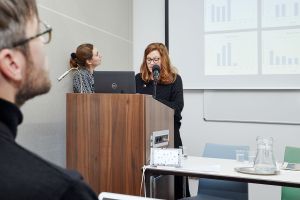
2023-12-05
#conference talk
The interwar era of the Czechoslovak Republic saw a flourishing art scene influenced by European modernism, notably from Paris. Artistic exchange and shared reproductions played a crucial role, facilitated by magazines such as Cahiers d’Art and Minotaure. The Mánes Association of Fine Artists (Spolek výtvarných umelců Mánes), founded by young Czech artists in 1887, acted as a hub for embracing and producing modern art trends, aiming to introduce foreign influences. Their primary activities included organizing exhibitions and publishing a prominent monthly art magazine, Volné směry (Free Tendencies, 1896–1949), which offered numerous large-format reproductions as one of its distinctive features.
Volné směry had editors and an editorial board consisting of engaged members of the Association. The painter Emil Filla and the sculptor Josef Wagner were the last two regular editors, Filla serving from 1933–1938 and Wagner from 1939–1944. Both were active and well-received artists, as well as essayists and art archivists. They were knowledgeable about both the local and international art scenes, with equal insight into traditional art and contemporary trends. After the war, they were active leaders, organizers, and respected university teachers. Both regularly commissioned photographs of their work from Josef Sudek, who was an associate photographer for the magazine. In addition, both artists collected reproductions, although Filla’s archive was more extensive (Winter ed. 2010).
Did Filla and Wagner reflect their artistic tastes during their respective editorial tenures? How did they shape the visual strategies of Volné směry? What was the magazine’s transnational reach during this period, and how did it influence the public? Can we think of Volné směry as a platform for disseminating progressive tendencies to the general public – mainly through the power of images – in order to shape a modern citizen? How did the magazine’s objectives shift during the war? To address these questions, we will draw upon archival materials from the Mánes Association (including documents related to Volné směry) and the personal archives of the artists. Additionally, distant viewing methods will provide a more comprehensive understanding of the magazine's orientation, choices, and reach. Statistical analysis will help us understand the evolution of reproduction composition in the interwar and wartime periods, with a special focus on author’s nationalities, artwork’s dates of origin, and reproduction sizes.
Art within Reach: Photomechal Reproductions of Work of Art from Print to Digital, 5–6 December 2023, Institute of Art History, Czech Academy of Sciences, Prague
Distant Viewing: Photomechanical Reproductions(by Viktorie Vítů and Fedora Parkmann)
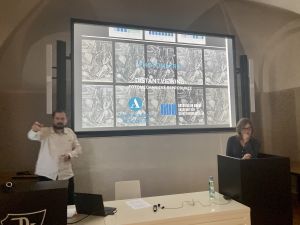
2023–11–09
#conference talk
In this talk, we introduced the methodology of the PhotoMatrix project and the first results of the statistical processing of the collected data. In the wake of distant reading computing tools, distant viewing opens a range of possibilities for scholars in art history, photography and visual studies. Our project applies methods of distant viewing to a specific type of image, the photomechanical reproduction of art, and aims to address the complexity of its multiple layers: a photograph of the artwork is taken, which is transferred to a printing matrix, which is then printed, together with a caption, and the periodical is digitized. The statistical analysis focused on captions of images published in the magazine Volné Směry and confirmed the connection between the editor of the magazine and the type of artworks published.
Presentation within the conference Humanitní a společenské vědy perspektivou Digital Humanities [Humanities and Social Sciences from the Perspective of Digital Humanities], Univerzita Palackého, Olomouc, Czech Republic, 9 November 2023.
Vilém Santholzer between Science and the Avant-Garde(by Viktorie Vítů)
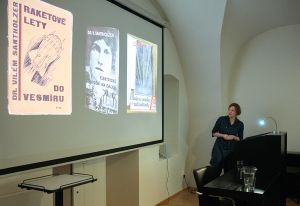
2023-02-22
#invited lecture
In the 1920s, Vilém Santholzer published several dozen articles on the beauty of machines, a text on the aesthetic power and authenticity of scientific photography, and even several of his own photographs of radioactive radiation in Czech avant-garde periodicals. The lecture will focus on the connection of this renowned radiologist, medical physicist, and tireless popularizer to Central European avant-garde circles, asking in particular about Santholzer's idea of beauty rooted in purpose and authenticity. It will thus show why he believed that modern airplane sculpture should surpass ancient sculpture and that the beauty of scientific photography should triumph over artistic photography.
Invited academic lecture by Viktorie Vítů, Collegium Historiae Artium lecture series, Institute of Art History of the Czech Academy of Sciences, Prague, 22 February 2023.
The Matrix of Photomechanical Reproductionsof Art: Research Project Presentation(by Hana Buddeus and Fedora Parkmann)
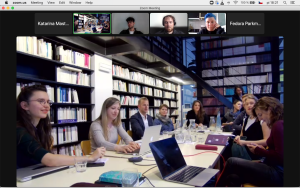
2022-09-23
#project presentation
An invited talk within the Research Seminar of the CEFRES by Hana Buddeus and Fedora Parkmann on 23 September 2022. The presenters introduced the PhotoMatrix project, which examines the rise and spread of photo-reproductions in Czech, French, German, and Russian art journals from 1900 to 1950. By combining digital humanities and archival research, the project aims to expand our historical knowledge from the local to the transnational, and from the empirical to big data, thus opening up new insights into the use of remote access to art in the digital age. This talk traced the various steps that led from the conception of the project to the submission of a proposal, and discussed the project’s methodology and goals.
Video presentation of the prize awarded to Fedora Parkmann
2023-01-02
#video profile
In 2022, the Czech Academy of Sciences represented by its President, Eva Zažímalová awarded the Lumina Quaeruntur Prize to six talented scholars, including the French & Czech researcher Dr. Fedora Parkmann from the Institute of Art History. The award has enabled Dr. Parkmann to establish and finance our research project for the next five years. On this occasion, a video presentation was made by the Czech Academy of Sciences. (In Czech only).
